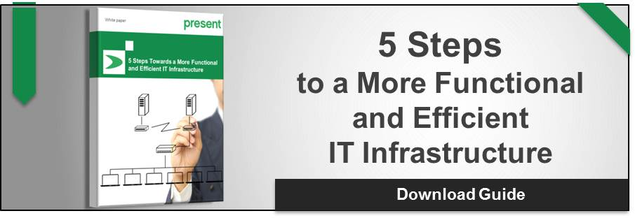Present Blog – IT Thought Leadership
Blog Present-IT thought leadership
Blog Present-IT thought leadership
IT thought leadership blog for CIOs and CTOs in Canada seeking resources to drive IT as a business contributor: hybrid cloud, infrastructure, managed services and security and IT recruitment.

Data backup is a critical responsibility for enterprises, because their business depends on access to this data at all times. In 2014, we still see backup procedures incompatible with data availability needs in many Canadian companies.
The practice of 3-2-1 is the basic rule of making backup copies. It entails keeping three copies of your data (including a production data set) on two different media types, one of which is located off-site. Keeping only one backup copy of your data is a risky practice. In the event that this copy is corrupted or unusable, it no longer allows for restoration.
At the same time, complying with the 3-2-1 rule, especially when budgets are tight, is not always easy.
Here are four recommendations to achieve this goal:
1- Test your backup copies regularly
A backup copy is meaningless if you can not use it to restore your data. The only way to ensure this is to test it, ideally by performing a full restore of your data. This is only possible in a virtualized environment, where a backup can be restored in minutes on a temporary virtual server, as many times as you want, which is in itself sufficient reason to consider virtualization if you have not already started down this path.
2- Use deduplication
To avoid the problem of corrupted data, the ideal course of action is to create two independent copies of production data. However this can become extremely costly since the amount of data to be stored is continually increasing. Deduplication saves storage space (and money) by identifying sequences of data that are identical and writing them only once. The space saved can be considerable: it is entirely possible to reduce a 1TB backup to only 50GB. Deduplication also makes it easier to implement the next recommendation.
3- Use a cloud service for your offsite backup
If your building burns, is flooded or suffers any disaster, your salvation will come only from your offsite copy. Using cloud based services has many advantages: they can run as background tasks, no need to transport any equipment and you can potentially restore your data from anywhere. However, the bandwidth requirement must be taken into account. Sending only deduplicated data offsite drastically reduces bandwidth requirements. You can also use WAN acceleration technology, available in the solution VEEAM Availability Suite v8, to further reduce the weight of data to transfer. Or even carrying out the first backup -by definition the more taxing- on tape or hard drive before installing offsite is also a good idea.
4- Backup on tape when appropriate
If backups in the cloud are beyond your budget or don’t meet your needs, the old tape storage format is still a viable option. This option is not recommended for your first-level backups because of the length of time required to restore from tape, but it is inexpensive, available everywhere and extremely durable. Even virtualized environments can now be easily backed up to tape, making it a good option for offsite backups.
Conclusion
It can be difficult to identify the optimal combination of solutions to implement a backup structure that meets all the needs of the business in terms of RTO / RPO and compliance. Modern technology for data protection coupled with virtual environments provides an optimal data protection by applying more easily the 3-2-1 rule, while respecting your budget.
Crédit photo : © .shock - Fotolia.com
About Blog
The right use of technology addresses business challenges and drives business growth in all areas of an enterprise. We hope this blog will offer insight into developing strategies and tactics to enable you to identify those key drivers of growth and keep pace with and anticipate the rapid technology change of today.
Posts by Topic
- IT infrastructure (116)
- IT security (92)
- IT Innovation (59)
- Trends (51)
- Cloud (47)
- Managed services (46)
- Mobility (38)
- Digital transformation (29)
- CIO/IT leaders (28)
- Events (28)
- News (23)
- Microsoft 365 (17)
- Security (17)
- IBM (16)
- Disaster recovery (DR) (14)
- High availability (12)
- Recruitment (12)
- Storage (12)
- Big Data (11)
- Collaboration (11)
- AI (9)
- Case study (9)
- Office 365 (9)
- BYOD (8)
- Customer Experience (8)
- Hybrid Cloud (7)
- Current events (6)
- SAP Hana (5)
- Business intelligence (BI) (4)
- Converged infrastructure (4)
- Convergence / Hyper-convergence (4)
- Virtualization (4)
- Copilot (3)
- Future of retail (2)
- Retail (2)
- trend (2)
- Backups (1)
- Beacon (1)
- Blog Migrations (1)
- Contests (1)
- Infrastructure TI (1)
- Innovation TI (1)
- IoT (1)
- MDM (1)
- Stockage (1)
- Virtualisation (1)
- blockchain (1)
- cio (1)
- replication (1)
- Étude de cas (1)

